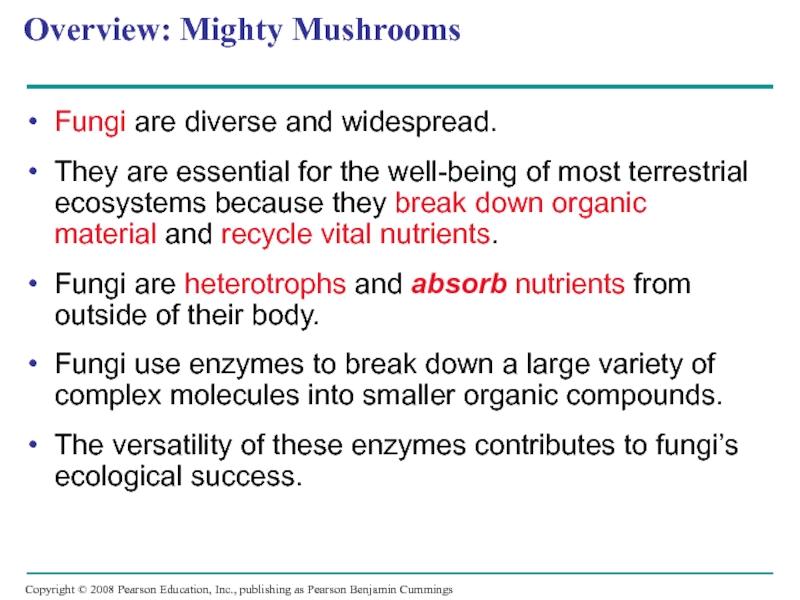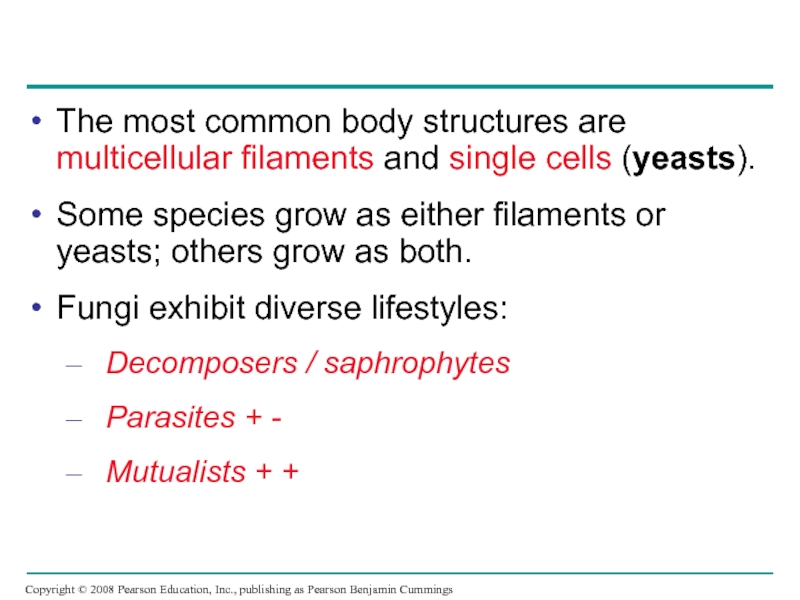Слайд 2Overview: Mighty Mushrooms
Fungi are diverse and widespread.
They are essential for
the well-being of most terrestrial ecosystems because they break down
organic material and recycle vital nutrients.
Fungi are heterotrophs and absorb nutrients from outside of their body.
Fungi use enzymes to break down a large variety of complex molecules into smaller organic compounds.
The versatility of these enzymes contributes to fungi’s ecological success.
Слайд 3The most common body structures are multicellular filaments and single
cells (yeasts).
Some species grow as either filaments or yeasts; others
grow as both.
Fungi exhibit diverse lifestyles:
Decomposers / saphrophytes
Parasites + -
Mutualists + +
Слайд 4Fungal Morphology : hyphae
The morphology of multicellular fungi enhances their
ability to absorb nutrients.
Fungi consist of mycelia, networks of
branched hyphae adapted for absorption.
Most fungi have cell walls made of chitin.
Слайд 5Multicellular Fungus:
hyphae …
Reproductive structure
Spore-producing
structures
Hyphae
Mycelium
20 µm
Слайд 6Septate fungi - Some fungi have hyphae divided into cells
by septa, with pores allowing cell-to-cell movement of organelles.
Coenocytic fungi
lack septa.
Some unique fungi have specialized hyphae called haustoria that allow them to penetrate the tissues of their host.
Слайд 7 Two forms of hyphae
(b)
Coenocytic hypha
Septum
(a) Septate hypha
Pore
Nuclei
Nuclei
Cell wall
Cell wall
Слайд 8Specialized Hyphae in Mycorrhizal Fungi + +
Mycorrhizae + + are
mutually beneficial symbiotic relationships between fungi and plant roots.
Ectomycorrhizal fungi
form sheaths of hyphae over a root and also grow into the extracellular spaces of the root cortex.
Arbuscular mycorrhizal fungi extend hyphae through the cell walls of root cells and into tubes formed by invagination of the root cell membrane.
Слайд 9Fungus - have specialized hyphae
(b) Haustoria - penetrate cell walls
of plants ++ or +-
(a) Hyphae adapted for trapping and
killing prey
Nematode
Plant
cell
wall
Haustorium
Plant cell
plasma
membrane
Plant cell
Fungal hypha
Hyphae
25 µm
Слайд 10Fungi produce spores through sexual or asexual life cycles
Fungi propagate
themselves by producing vast numbers of spores, either sexually or
asexually.
Fungal nuclei are normally haploid.
Sexual reproduction requires the fusion of hyphae from different mating types.
Fungi use sexual signaling molecules called pheromones to communicate their mating type.
Слайд 11 Life Cycle of Fungi
Spores
Spore-producing
structures
GERMINATION
ASEXUAL
REPRODUCTION
Mycelium
Key
Heterokaryotic
(unfused nuclei from
different parents)
Haploid (n)
Diploid
(2n)
SEXUAL
REPRODUCTION
KARYOGAMY
(fusion of nuclei)
PLASMOGAMY
(fusion of cytoplasm)
Heterokaryotic
stage
Zygote
2n
Spores
GERMINATION
MEIOSIS
Слайд 12Plasmogamy is the union of two parent hyphae, mycelia.
In most
fungi, the haploid nuclei from each parent do not fuse
right away; they coexist in the hyphae, this mycelium is called a heterokaryon.
In some fungi, the haploid nuclei pair off two to a cell; such a mycelium is dikaryotic.
During karyogamy, the haploid nuclei fuse, producing diploid cells: n + n = 2n.
Слайд 13Hours, days, or even centuries may pass before the occurrence
of karyogamy, nuclear fusion.
The diploid phase is short-lived and undergoes
meiosis, producing haploid spores.
Слайд 14Asexual Reproduction
In addition to sexual reproduction, many fungi can reproduce
asexually.
Molds produce haploid spores by mitosis and form visible mycelia.
Other
fungi that can reproduce asexually are yeasts, which inhabit moist environments.
Instead of producing spores, yeasts reproduce asexually by budding: simple cell division and pinching of “bud cells” from a parent cell.
Слайд 15Penicillium: a mold that decomposes food.
Mold produce spores asexually
by mitosis.
2.5 µm
Слайд 16The yeast Saccharomyces cerevisiae in several stages of asexual reproduction
by budding.
10 µm
Parent
cell
Bud
Слайд 17Concept 31.3: The ancestor of fungi was an aquatic, single-celled,
flagellated protist
Fungi and animals are more closely related to each
other than they are to plants or other eukaryotes.
DNA evidence suggests that fungi are most closely related to unicellular nucleariids while animals are most closely related to unicellular choanoflagellates.
This suggests that fungi and animals evolved from a common flagellated unicellular ancestor and multicellularity arose separately in the two groups.
The oldest undisputed fossils of fungi are only about 460 million years old.
Слайд 18Fungi and their close relatives
Animals (and their close
protistan relatives)
Other fungi
Nucleariids
Chytrids
UNICELLULAR,
FLAGELLATED
ANCESTOR
Fungi
Opisthokonts
Слайд 19The Move to Land
Fungi were among the earliest colonizers of
land and probably formed mutualistic ++ relationships with early land
plants.
Chytrids (phylum Chytridiomycota) are found in freshwater and terrestrial habitats.
They can be decomposers, parasites, or mutualists.
Chytrids are unique among fungi in having flagellated spores, called zoospores.
Слайд 20Fungus Diversity
Chytrids (1,000 species)
Zygomycetes (1,000 species)
Hyphae
25 µm
Glomeromycetes (160 species)
Fungal hypha
Ascomycetes
(65,000 species)
Basidiomycetes (30,000 species)
Слайд 21Zygomycetes
The zygomycetes (phylum Zygomycota) exhibit great diversity of life histories.
They
include fast-growing molds, parasites, and commensal symbionts.
The zygomycetes are named
for their sexually produced zygosporangia.
Zygosporangia, which are resistant to freezing and drying, can survive unfavorable conditions.
Слайд 22Life Cycle of the zygomycete Rhizopus black bread
mold
Rhizopus
growing
on bread
SEXUAL
REPRODUCTION
Young
zygosporangium
(heterokaryotic)
Gametangia with
haploid nuclei
Mating
type (–)
Mating
type (+)
Diploid (2n)
Haploid (n)
Heterokaryotic (n +
n)
PLASMOGAMY
Key
Diploid
nuclei
Zygosporangium
100 µm
KARYOGAMY
MEIOSIS
Sporangium
Spores
Dispersal and
germination
ASEXUAL
REPRODUCTION
Dispersal and
germination
Sporangia
Mycelium
50 µm
Слайд 23Some zygomycetes, such as Pilobolus, can actually “aim” their sporangia
toward conditions associated with good food sources.
0.5 mm
Слайд 24Ascomycetes
Ascomycetes (phylum Ascomycota) live in marine, freshwater, and terrestrial habitats.
The
phylum is defined by production of sexual spores in saclike
asci, usually contained in fruiting bodies called ascocarps.
Ascomycetes are commonly called sac fungi.
Ascomycetes vary in size and complexity from unicellular yeasts to elaborate cup fungi and morels.
Слайд 25Ascomycetes - sac fungi
Tuber melanosporum, a truffle
Morchella esculenta,
the tasty morel
Слайд 26Ascomycetes include plant pathogens, decomposers, and symbionts
Ascomycetes reproduce asexually by
enormous numbers of asexual spores called conidia.
Conidia are not formed
inside sporangia; they are produced asexually at the tips of specialized hyphae called conidiophores.
Neurospora is a model organism with a well-studied genome.
Слайд 27Key
Haploid (n)
Diploid (2n)
Dikaryotic (n + n)
Conidiophore
Mycelium
ASEXUAL
REPRODUCTION
Germination
Hypha
PLASMOGAMY
Haploid spores (conidia)
Conidia;
mating type (–)
Mating
type
(+)
SEXUAL
REPRODUCTION
Dikaryotic
hyphae
Ascus
(dikaryotic)
Mycelia
KARYOGAMY
Diploid nucleus
(zygote)
Germination
Asci
Dispersal
Dispersal
Ascocarp
Eight
ascospores
Four
haploid
nuclei
MEIOSIS
The life cycle of Neurospora, an ascomycete
Слайд 28Basidiomycetes
Basidomycetes (phylum Basidiomycota) include mushrooms, puffballs, and shelf fungi, mutualists,
and plant parasites.
The phylum is defined by a clublike structure
called a basidium, a transient diploid stage in the life cycle.
The basidiomycetes are also called club fungi.
Слайд 29Basidiomycetes club fungi
Shelf fungi, important
decomposers of wood
Maiden veil fungus
(Dictyphora), a
fungus
with an
odor like rotting
meat
Puffballs emitting
spores
Слайд 30Concept 31.5: Fungi play key roles in nutrient cycling, ecological
interactions, and human welfare
Fungi interact with other organisms in many
ways.
Fungi are efficient decomposers. They perform essential recycling of chemical elements between the living and nonliving world.
Fungi form mutualistic relationships with plants, algae, cyanobacteria, and animals.
All of these relationships have profound ecological effects.
Слайд 31Fungus-Plant Mutualisms + +
Mycorrhizae live ++ symbiotically in plant roots
and are enormously important in natural ecosystems and agriculture.
Plants harbor
harmless symbiotic endophytes that live inside leaves or other plant parts ++
Endophytes make toxins that deter herbivores and defend against pathogens.
Слайд 32Do endophytes benefit a woody plant?
Both endophyte and pathogen present
(E+P+)
Endophyte not present; pathogen present (E–P+)
Leaf area damaged (%)
Leaf mortality
(%)
30
10
20
10
15
5
0
0
E+P+
E–P+
E–P+
E+P+
RESULTS
Слайд 33Fungus-Animal Symbioses
Some fungi share their digestive services with animals.
These fungi
help break down plant material in the guts of cows
and other grazing mammals.
Many species of ants and termites use the digestive power of fungi by raising them in “farms.”
Слайд 34Fungus-gardening insects: Leaf-cutting ants depend on fungus to digest plant
material to a form the insects can use for their
nutrition + +.
Слайд 35Lichens
A lichen is a ++ symbiotic association between a photosynthetic
microorganism and a fungus in which millions of photosynthetic cells
are held in a mass of fungal hyphae.
The fungal component of a lichen is most often an ascomycete.
Algae or cyanobacteria occupy an inner layer below the lichen surface.
Слайд 36Variety of lichens + +
A foliose
(leaflike)
lichen
A fruticose (shrublike) lichen
Crustose
(encrusting)
lichens
Слайд 37Anatomy of a common fungal ascomycete lichen
Algal cell
Ascocarp of fungus
Soredia
Fungal
hyphae
Fungal
hyphae
Algal
layer
20 µm
Слайд 38The algae provide carbon compounds, cyanobacteria provide organic nitrogen, and
fungi provide the environment for growth.
The fungi of lichens can
reproduce sexually and asexually. Asexual reproduction is by fragmentation or the formation of soredia, small clusters of hyphae with embedded algae.
Lichens are important pioneers on new rock and soil surfaces -- pioneer organisms in ecological succession.
Lichens are sensitive to pollution, and their death can be a warning that air quality is deteriorating.
Lichen ++
Слайд 39Fungi as Pathogens + -
About 30% of known fungal species
are parasites or pathogens, mostly on or in plants.
Some fungi
that attack food crops are toxic to humans.
Animals are much less susceptible to parasitic fungi than are plants.
The general term for a fungal infection in animals is mycosis.
Слайд 40Fungal Diseases in Plants
(c) Ergots on rye
(a) Corn smut on
corn
(b) Tar spot fungus on
maple leaves
Слайд 41Practical Uses of Fungi
Food: Humans eat many fungi and use
others to make cheeses, alcoholic beverages, and bread.
Some fungi are
used to produce antibiotics for the treatment of bacterial infections, for example the ascomycete Penicillium.
Genetic research on fungi is leading to applications in biotechnology:
For example, insulin-like growth factor can be produced in the fungus Saccharomyces cerevisiae.
Слайд 42Penicillium: Fungal production of an Antibiotic
The mold penicillium
produces an antibiotic that inhibits bacteria growth resulting in a
clear area between the mold and the bacteria
Staphylococcus
Zone of
inhibited
growth
Penicillium
Слайд 44You should now be able to:
List the characteristics that distinguish
fungi from other multicellular kingdoms.
Discuss mycorrhizal fungi.
Describe the processes of
plasmogamy and karyogamy.
Describe the evidence that multicellularity evolved independently in fungi and animals.
Слайд 45Describe the life cycles of Rhizopus stolonifer and Neurospora crassa.
Distinguish
among zygomycetes, ascomycetes, and basidiomycetes.
Describe some of the roles of
fungi in ecosystems, lichens, animal-fungi mutualistic symbioses, food production, and medicine and as pathogens.
































































